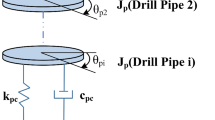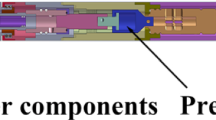It is generally recognized that the stick-slip motion of a polycrystalline diamond compact (PDC) bit is responsible for the low rate of penetration (ROP) and premature failure of the PDC bit when drilling in hard rock formations. To solve this problem, a torsional vibration damping tool was developed. A working principle model of the tool and a calculation model of the optimal spiral angle of the tool was established. The stability of the tool was analyzed, and the parameter range of spiral guideline thread stability was determined. The analysis revealed that the tool can automatically adjust the weight on the bit (WOB) and the rotary speed of the PDC bit through the spiral guide and the disc spring, which could suppress the torsional vibration of the PDC bit and convert part of the vibration load into cutting torque for rock breaking and thus to improve the rate of penetration (ROP). The optimal spiral angle of the tool is proportional to the axial stiffiless, bit diameter, and rock hardness of the drill string system and inversely proportional to the torsional stiffness of the drill string system and the reclining angle of the PDC bit. The stability of the tool is related to the spiral angle, length, and friction angle of the spiral guide. The tools were applied in test wells, and the results indicate that the torque fluctuations are significantly decreased and effectively extend the service life of the PDC bit. During the test process, the tool exhibits steady performance, the feasibility of the tool calculation model was verified. It is anticipated that the presented results will make such drilling a more feasible method for well services.









Similar content being viewed by others
References
S. Jardine, D. Malone, and M. Sheppard, “Putting a damper on drilling’s bad vibrations,” Oilfield Rev., 6(1), 15-20 (1994).
J.F. Brett, “The genesis of torsional drillstring vibrations.” SPE Drill. Eng.. 7(3). 168-174 (1992).
A. Depouhon and E. Detournay, “Instability regimes and self-excited vibrations in deep drilling systems,” J. Sound Vibr., 333(7), 2019-2039 (2014).
C. Germay, N.V. Wouw, H. Nijmeijer, and R. Sepulchre, “Nonlinear drillstring dynamics analysis,” SIAM J. Appl. Dyn. Syst., 8(2), 527-553 (2009).
H. Henneuse, “Surface detection of vibrations and drilling optimization: field experience,”IADC/SPE Drilling Conference, New Orleans, Lousiana, February 18-21 (1992).
P. Sananikone, O. Kamoshima, and D.B. White, “A field method for controlling drillstring torsional vibrations,” in IADC/SPE Drilling Conference, New Orleans, Lousiana, February 18-21 (1992).
F. Abbassian and V. A. Thmayevsky, “Application of stability approach to torsional and lateral bit dynamics,” SPE Drill. Complet., 13(2), 99-107 (1998).
C. Canudas-de-Wit, F. IL Rubio, and M. A. Corchero, “D-OSICIL: a new mechanism for controlling stick-slip oscillations in oil well dralstrings,”IEEE Trans. Cont. Sys. Technol., 16(6), 1177-1191 (2008).
U. J. F. Aarsnes and N. van de Wouw, “Dynamics of a distributed drill string system characteristic parameters and stability maps,” J. Sound Vibr., 417, 376-412 (2018).
A. Ghasemloonia, D. G. Rideout, and S. D. Butt, “Analysis of multi-mode nonlinear coupled axial-transverse dralstring vibration in vibration assisted rotary drilling,” J. Pet. Sci. Eng., 116, 36-49 (2014).
GW. Halsey, A. Ryllingstad, and A. Rylling, “Torque feedback used to cure slip-stick motion,” in SPE Annual Technical Conference and Exhibition, Houston, Texas, 2-5 October (1988).
J.D. Jansen and L. van den Steen, “Active damping of self-excited torsional vibrations in oil well drillstrings ”J. Sound Mir., 179(4), 647-668 (1995).
D R. Pavone and J.P. Desplans, “Application of high sampling rate downhole measurements for analysis and cure of stick-slip in drilling,” in SPE Annual Technical Conference and Exhibition, New Orleans, Louisiana, 25-28 September (1994).
H. Henneuse, “Surface detection of vibrations and drilling optimization: field experience,” in IADC/SPE Drilling Conference, New Orleans, Lousiana, 18-21 February (1992).
E. M. Navarro-Lopez and R. Suarez-Cortez, "Practical approach to modelling and controlling stick-slip oscillations in oily/ell drillstrings," IEEE International Conference on Control Applications, Taipei, Taiwan, 2-4 September (2004).
J. M. Kamel and A. S. Yigit, “Modeling and analysis of stick-slip and bit bounce in oil well drillstrings equipped with drag bits,”J. Sound Vibr., 333, (2014).
T. Richard, E. Detournay, M.Fear, et al. “Influence of bit-rock interaction on stick-slip vibrations of PDC bits,” SPE Annual Technical Conference and Exhibition, San Antonio, Texas, SPE 77616, 29 September — 2 October (2002).
E. Detournay, T. Richard, and M. Shepherd, “Drilling response of drag bits: theory and experiment,” Int. J. Rock Mech. Min. Sci., 42(8), 1347-1360 (2008).
T. Richard, F. Dagrain, E. Poyol, and E. Detournay, “Rock strength determination from scratch tests,” Eng. Geol., 147, 91-100 (2012).
L. L. Cui, Z. Jin, J. F. Huang, and H.Q. Wang, “Fault severity classification and size estimation for ball bearings based on vibration mechanism,” IEEE Access, 7, 56107-56116 (2019).
Acknowledgment
This research was supported by the National Natural Science Foundation of China (Grant No. 51804013) and National Science and Technology Major Project (Grant No.2016Z105021-003).
Author information
Authors and Affiliations
Additional information
Translated from khimiya i Tekhnologiya Topliv i Masel, No. 5, pp. 67 —73, September — October, 2020.
Rights and permissions
About this article
Cite this article
Zha, C., Dong, Z., Zhu, L. et al. Development and Dynamic Analysis of a Torsional Vibration Damping Tool for PDC Bit. Chem Technol Fuels Oils 56, 807–820 (2020). https://doi.org/10.1007/s10553-020-01193-9
Published:
Issue Date:
DOI: https://doi.org/10.1007/s10553-020-01193-9




